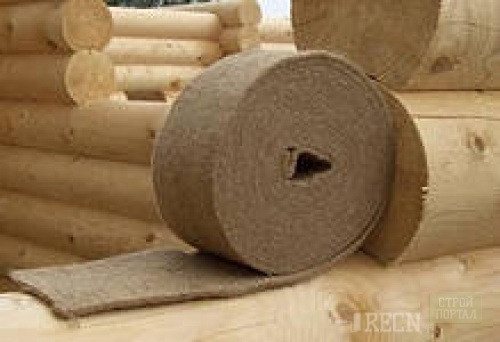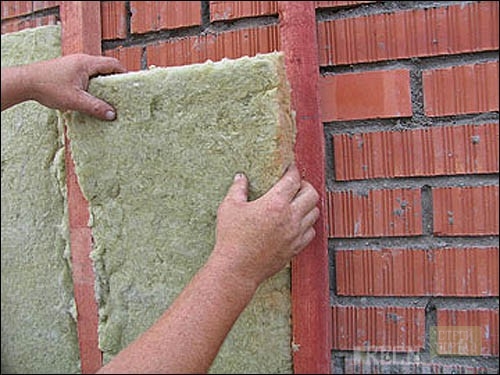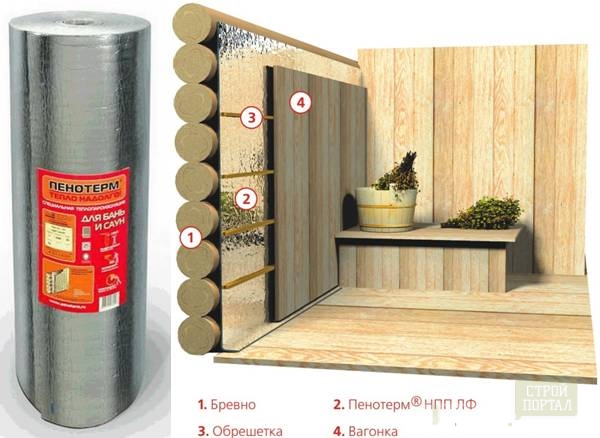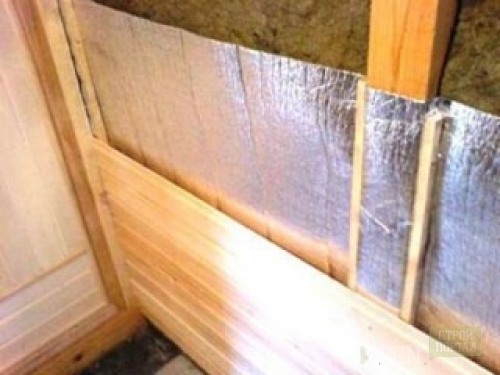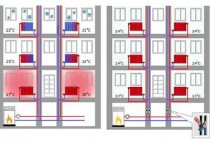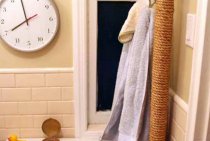How to properly insulate the walls of the bath
The procedure for warming a wooden frame
The insulation of the walls of a wooden bath must be taken care of at the stage of its construction. For this, there is an interventional heater for the bath. It is laid between the logs of the log house. Such heaters have a natural base of felt, jute, hemp hemp, linen tow. Natural heaters provide natural air exchange in the room.
Jute fiber does not rot and does not absorb moisture. Durable insulation is flax-jute felt, which combines the strength of flax and the water-repellent properties of jute.
- When building walls, insulation is placed between the crowns.
- After the complete assembly of the log house, the joints of the logs are sealed, sealing the insulation with a special caulk.
- Sealed seams are sealed.
How to insulate the walls of a bath made of bricks or foam blocks from the outside
It is possible to insulate the walls of a brick bath from the outside using a ventilated facade device. A frame is mounted on the walls, then a heater and a waterproofing agent are attached. The work is completed by sheathing the frame with materials for building facades - siding or plastic clapboard.
 The procedure for installing a ventilated facade is as follows:
The procedure for installing a ventilated facade is as follows:
- Treat the wall surface with an antifungal primer.
- Install the aluminum profile vertically at a distance of 0.8-1 m from each other.
- Fill the space between the profiles with a layer of insulation.
- Close the joints between the plates of thermal insulation material with adhesive tape or fill with adhesive.
- Secure the waterproofing with rails.
- Install horizontal rails from the profile for further fastening of the facing material.
- Sheathe the finished frame with finishing material for facade cladding.
The technology of wall insulation inside the bath with thermal insulation Penoterm
- Insulation is attached to the walls of the bath vertically. The wooden surface does not require preparation.
- Unwind the roll and cut the required number of strips with an allowance of 10 cm to the height of the walls.
- Secure the material with a stapler with the foil side inward. The material is attached with an overlap.
- Do not cut off excess material along the length, but wrap it on the floor. This method of installation will ensure the removal of condensate.
- Glue the seams with metallic tape.
- Install a wooden crate for the subsequent installation of the lining.
- Perform the installation of wooden lining.
Insulation of the walls of a brick bath from the inside
The principle of installation of internal thermal insulation of the walls of a bath made of bricks or foam blocks is the same as outside.
The difference is that a wooden crate is mounted inside the bath, and not a metal one.
After laying the insulation and waterproofing membrane or film, the crate is sheathed with wooden clapboard.
Warming the walls of the bath with your own hands, performed in accordance with all the rules, will help keep the heat in the bath and preserve your health.
Thermal protection methods
There are two ways to insulate the base - before and after laying. The first method is applied before pouring cement. Insulators are laid on the outer side of the foundation wall above and below ground (if there is a tunnel). The insulation of the underground part of the foundation block in contact with the ground is additionally covered with a protective layer. If the foundation block is shallow, its sole is also subject to thermal insulation.

Often builders use formwork instead of an insulating layer. The structure is not assembled from wood, but from expanded polystyrene. Therefore, it does not need to be removed after the concrete mortar has dried.It is a good heat-insulating material, does not deteriorate under the influence of environmental factors. Wooden boards, unfortunately, are prone to rotting.
The second method is used after the construction of the building. In fact, it is equated to the insulation of the height of the basement. The base, as with internal insulation, is protected by a blind area. This method is simpler, more economical, but less effective, since it is applied only to the front side of the foundation.
Features of warming the frame bath from the outside
If you need to insulate the walls of a frame bath, then it is best to use foam for this. In this case, the lightness of this material plays a decisive role. Although there are other advantages, for example, hydro-repellent properties and low thermal conductivity.
It is possible to insulate a frame bath from the outside with the help of foam plates, even without having the skills to work with this material. The insulation must simply be glued to the wall or fixed with self-tapping screws, and plaster or decorative facade cladding should be applied on top. The disadvantage of foam plastic is its fragility, which is why it is necessary to be especially careful when working with this material.
What materials can be used for thermal protection
Previously, builders used sand, expanded clay, and earth to create a heat-shielding shell. They were buried around dug foundation blocks and between them. Expanded clay and sand have thermal insulation, waterproofing, drainage properties.
These materials reduce the force of soil pressure on the wall, which allows their use on clay soils. Such measures were explained by the lack of an alternative or financial opportunity. In addition, sand, expanded clay layers can be poured independently without the involvement of a construction team.
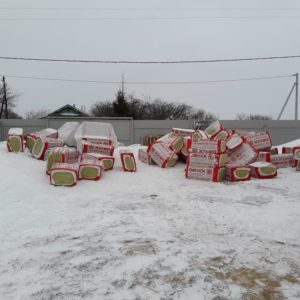
- need additional moisture-resistant protection, because they are prone to getting wet;
- mounted on a frame base, because they do not have the necessary rigidity;
- subject to sagging, which negates thermal insulation characteristics.
Due to the problems of mineral wool, a new type of insulation has appeared - bituminous mastic. This mixture covers microcracks, gaps, cracks in the foundation, protecting it from moisture, partially warming it.
Styrofoam became the next step in the development of building heat insulators. The material is very resistant to temperatures, loads and accidental damage, easy to install. From above, this material must be treated with plaster, because under the influence of direct sunlight the material turns yellow and loses its qualities. In addition, it is spoiled by rodents.
At the top step in the development of insulation is polyurethane foam (or its equivalent - expanded polystyrene). It has not only thermal insulation, waterproofing qualities, but also soundproofing. This material:
- durable;
- tight;
- steam and waterproof;
- reliable;
- depending on the form of use, it can be seamless;
- has low thermal conductivity.
The weak side of polyurethane foam is susceptibility to destruction under the influence of sunlight.
The range of thermal insulation is diverse. The choice depends on the budget laid down for the construction of the bath, the planned time of operation of the building, and the time frame.
 insulated foundation
insulated foundation
Why carry out such a procedure
Before you engage in sheathing, insulation of walls and foundations in the bath, you need to understand why this is necessary. Thermal insulation allows:
- Keep the heat in the room.
- To prevent the destruction of the foundation of the building due to moisture. The liquid penetrating into the micropores of the foundation under the influence of temperature changes expands small holes, forming cracks.
- Increase the rigidity of the base.
- Warm up the floors of the building.
- Reduce heating costs.
- Normalize the temperature in the room.
Insulation is not needed when the bath is built without a foundation (mobile or lightweight construction).
In addition to the practical purpose, the thermal insulation of the basement is necessary to give the building a finished look.
It is important to take care not only about the insulation of the base. The plinth also needs to be processed
What materials are suitable for warming a bath
- In order to keep warm in the heated bath for a long time, it is necessary to insulate the walls of the bath from both sides. Heaters for internal thermal insulation must be environmentally friendly and meet sanitary standards.
- Mineral wool insulation has a low thermal conductivity. It has a high hygroscopicity, so it needs reliable waterproofing. For interior decoration, its use is undesirable. Under the influence of high temperatures, mineral wool releases harmful substances. When using mineral wool indoors, waterproofing is necessary not only to protect the material from moisture, but also as a barrier against harmful fumes entering the room.
- Polystyrene also emits harmful substances when heated. For this reason, it is not used for internal thermal insulation of the bath.
- Finnish sauna heater SPU Sauna-Satu has a high thermal insulation capacity. Available in 600x1200 mm slabs. Thickness 30 mm. The material does not support combustion. Does not absorb moisture. Due to the fact that the material does not emit harmful fumes when heated, SPU Sauna-Satu insulation is recommended for indoor use. In particular - for finishing the steam room and sauna. Installation is carried out directly on the wall without a crate.
- Insulation of the walls of the bath from the outside pursues the goal - to protect the building structure from atmospheric influences - cold air and precipitation. The method of insulation is chosen depending on the building materials from which the bath is built. For outdoor insulation, almost any type of insulation is suitable.
- To insulate the walls of the frame bath, you should choose a material with a low weight so as not to create an excessive load on the walls.
- Especially for finishing the steam room, foil thermal insulation Penoterm NPP LF is produced. This insulation is made of NPP expanded polypropylene, laminated with aluminum foil on one side. Combines the qualities of heat and waterproofing. The material is resistant to high temperatures. It has a thickness of 3 to 10 mm.
- To insulate brick walls with high thermal conductivity, a material with a thickness of 8-100 mm is required. For wooden baths, a heater with a thickness of 3 to 5 mm is suitable.
-
For the device of vapor and waterproofing, special materials are used. GEKSA produces Izospan films and membranes. The correct waterproofing device helps to maintain the properties of the insulation and prevents the formation of condensate.
Features and technology of warming the foundation of the bath
Insulation of the bath from the inside must begin with the floors. However, before this, it is necessary to perform the insulation of the foundation. If this is not done, then no matter how insulated and reliable the floors of your bath are, cold air will still penetrate inside.
If we consider the foundation from the point of view of possible heat losses, then it can be divided into 2 zones: the underground part and the basement. Accordingly, the insulation of the steam room foundation can be performed in 2 ways. The underground part is insulated with a layer of expanded clay, the height of which should be approximately 2 times greater than the thickness of the walls. Then the plinth is sheathed on the outside with mineral wool or extruded polystyrene foam.
Technologically, the insulation of the foundation is not particularly difficult. It is acceptable to use 1 of 2 possible options. The insulation of the foundation is carried out to the level of freezing of the soil. This parameter is determined separately for each region.When installing a heat-insulating material to a great depth, the efficiency of using a heater is significantly reduced. In the corner zones, the heat-insulating layer must be increased by 1.4-1.6 times.
If the foundation is insulated with extruded polystyrene foam, there is no need for additional laying of a protective coating for the waterproofing layer, which would protect it from mechanical damage.
In preparation for pouring the foundation, the trench and formwork for pouring the foundation are made wider than the calculated dimensions per sheet thickness, and even better, even 2 sheets of polystyrene insulation. The insulation is attached to the foundation surface after the formwork has been removed. The part of the foundation that rises above the ground can be trimmed with decorative stone or tiles directly on the heat-insulating material. This completes the insulation of the foundation of the bath.
